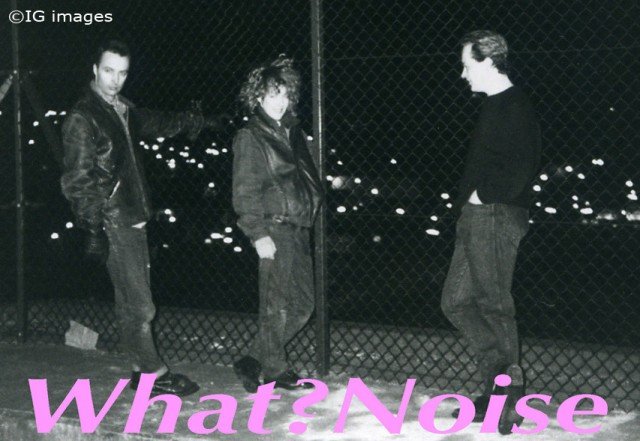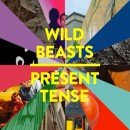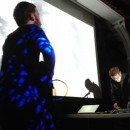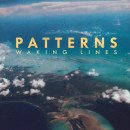Back into the mists of time, well, 1989/1990 to be precise, the stereo of the sixth form common room of the Kingsway school was tuned into the test signal from an ex-pirate radio station soon to turn legit. KFM broadcast a wide variety of new music, all without DJ interruptions as they hadn’t been hired yet. It lasted a few months or so, then KFM launched officially, and promptly started to chase ratings. Within a year it had lost the unique identity that the test signal had established and became just another commercial station. It had also lost the Kingsway sixth form as an audience (someone brought in a Stone Roses cassette and we never looked back), but by then KFM had done its work. I was aware of “Wobble” by What?Noise, and my life would never be the same again.
Who the hell are What?Noise? They were a side project of (then) husband and wife team Chris and Julia Nagle with vocals provided originally by Tim Harris and later by Mark Hoyle. Chris Nagle was already one of the most sought-after sound engineer/producers in the area having worked with the Charlatans, Dub Sex, and the Inspirals. He was also an artist with the Akai S1000 sampler, a museum piece now but at the time it was the latest thing, a box that had the ability to sample any sound in CD quality and stretch it over time without altering the pitch. An argument can be made for this rack-mounted piece of kit to be included on any list of the most important instruments of the 20th century but that’s for another article. Suffice to say Chris Nagle had read the manual and discovered that he and the Akai were made for each other. Combined with some Atari computers and sequencers the Nagles had the tools and the talent. They also knew how to pick a singer. Tim Harris’s style was best described as unique. Sounding alternately drug-addled or hysterical his singing helped to make the What?Noise experience, through the “Vein” EP (1989) and album “Fat” (1990), utterly unique. Unsurprisingly they didn’t trouble the top 40. Later, after Tim Harris literally disappeared off the face of the earth, the vocal duties were taken over by Mark Hoyle. Mark had already done time as singer for Dub Sex and was later to form Dumb, the great live band of the Manchester 90s. In between he donated his characteristic yelp to What?Noise live performances between 1990-1993, and recorded a selection of tracks (some of which were interesting prototypes of soon-to-be Dumb anthems) that didn’t see the light of day for another 13 years.
So back to the Kingsway sixth form common room and the KFM test signal. The air is thick with hormones and homework, reversed ties and big hair. On comes “Wobble” and I put down my quadratic equations and listen in wonder. I’m not proud of my musical tastes at that time. My elder brother’s music collection, which I now grudgingly admit to have been quite remarkable full as it was of The Wedding Present, The Smiths, Grandmaster Flash, The Residents, early Prefab Sprout, The Field Mice, was all just noise to me. But all it took for me to get with the program was “Wobble”. It starts with a quiet metallic chug like a car turning over, chugee chug chug chug chug chug chug chug. Nothing else. By the third repeat it has your attention because it’s doing so little. Then you’re pummelled by a drum machine the likes of which you just don’t hear any more. Sounding like an robot car factory being played by Afrikaa Bambaataa it’s all sand-papered high-hats, pounding kick drums, and snares like steel sheets. Then rumbling bass, electric guitars that descend on cue into a frenzied cacophonies, and Tim Harris shouting “Pol Pot is off his head”, all adds to the glorious madness. The track eventually works itself into a frenzy as a distorted buzzing noise like a swarm of angry bees threatens to overpower everything, then it blows itself out piece by piece leaving the drum machine to finish where it started and a lone guitar howling in feed-backed pain into the emptiness.
I have no idea why but it was love at first listen. The combination of heavy guitars and electronics was already being played around with by other bands but no one was taking it to these extremes. It wasn’t polished smooth like Garbage, or commercialized like Jesus Jones, or sexy like Curve. It was raw, experimental, and mental. The rest of the album “Fat” was just as out-there. “P.O.W” is an eye-witness narrative of an war crime in progress set to a sequenced backing track that sounds like a hi-tech newsroom. “Eventually” is as doom-laden as the Cure on a bad day. “Obliv” is just plain weird. On the other hand “Crash” is a rather poppy love song, “Anybody” is the What?Noise you can dance to with your hands in the air, and “Change” is a chant-along with a full-on heads-down go mental meltdown to finish. And of course, “Wobble” is there, the intense, brutal, rampaging monster that remains in my all-time top five today.
With “Fat”, Chris, Julia, and Tim expanded on the blueprint laid down with the earlier “Vein” EP, making full use of the wider canvas afforded by the full length album to create something that screams of creativity and exploration. Of course it sounds dated today. The technology was new, but this gave the sound character. Ask yourself, what does a modern drum machine or keyboard sound like? Whatever you want it to sound like is the answer, but it won’t have a sound of its own. An early Moog could only play one note at a time. A Roland TR808’s attempt at an authentic bass drum sounded like nothing other than a TR808 bass drum. Today’s electronic instruments have evolved to the point where they can perfectly mimic other instruments, or be modified without limit. But they no longer have character because their character came from their limitations. “Fat” by What?Noise is full of character, not just from the new but limited technology Chris and Julia had to play with, but from the sheer gusto with which they explored these limitations. It’s the sound of creative types working throughout the night at Strawberry Studios (cheaper hourly rates), fuelled by coffee and ideas, making extreme sounds that had never been heard before, making music for themselves. You can’t say that “Fat” was a real revolution, no one bought it and you can’t have a revolution without followers. But it was a revolution of sorts for me. Perhaps you had to be there.
More info on the people behind What?Noise can be found here thanks to Julia Adamson (previously Julia Nagle) and her Invisible Girl: http://www.invisiblegirl.co.uk/home.html
What?Noise tracks including an expanded and re-sequenced/re-mastered version of “Fat” and the Mark Hoyle recordings are now available on iTunes.
Comments from Facebook
comments






I’ve been exploring for a bit for any high quality articles or blog posts in this kind of area . Exploring in Yahoo I at last stumbled upon this site. Studying this information So i am happy to convey that I’ve a very good uncanny feeling I discovered just what I needed. I most indisputably will make sure to do not disregard this web site and provides it a glance on a constant basis.